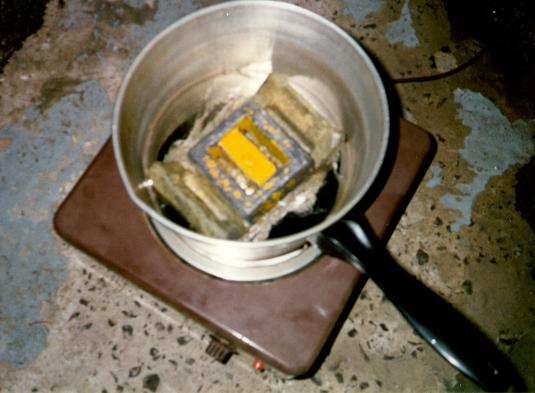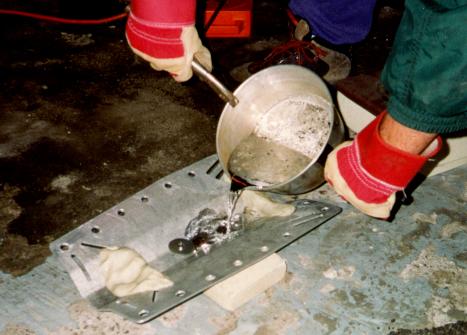I've mentioned how the mighty St. Lawrence
provides excellent opportunities for technical diving with deep drifts,
deep wrecks, strong current and great penetrations. However, remember that
while the locals are often aclimatised to the conditions here, you may
not be. So, if you are visiting, be on the cautious side...
....and certainly do not attempt anything beyond your
training or equipment or comfort level.
So, you've been diving for several seasons with two
or three hundred dives in different environments. Now maybe you want to
enter that engine room, dive that wreck at 150 feet that you've heard of
or maybe just do a deep drift. You are ready to take up "technical" diving.
What distinguishes technical diving from recreational
diving is that the latter is designed to always allow you a direct ascent
to the surface if necessary. The overhead environment of a technical dive
prohibits this, whether it's due to penetration of a wreck, a cave (not
my cup of tea) or a decompression stop obligation, also known as an invisible
or glass ceiling.
Get ready to be a newbie all over again.
That last point is very important. You buy the gear,
you buy the lessons and you do not go immediately to dive the Jodrey or
Doria; at least not if you wish to go past GO and collect 200 dives. Don't
forget you've now got a new harness, BCD, tanks, extra regulators and dingle-dangles
all over the place. You should go directly to Prescott Docks and try the
gear out. I found my tanks were so high, I kept falling over forwards and
that my harness webbing was inadequate. Second dive for me was that old
favourite, the Rothesay. So I look a little foolish diving a 25 foot, shore
accessible, wreck with little current from a zodiac wearing twin steel
tanks and full regalia; but where else am I going to practice my first
boat entry and exit - certainly not on the Daryaw. After a dozen or so
dives under your belt, you begin to feel more comfortable, just like your
PADI OW days.
Much is written about equipment and technique and a
lot is available on the web. I recommend that you be willing to study and
discuss these subjects to arrive at the best arrangement. Here are web
pages of two dive buddies from Quebec that explain how I dive, this
one in English, ceci en français
and this is
another useful page. Following
are a few pointers of my own.
HARNESS
People wear all manner of harnesses and these are a
subject of constant debate. Two common objections to the Hogarth style
harness are that it must be difficult to put on and take off and that the
crotch strap must be uncomfortable. In fact, with the Hogarth harness,
you wear the shoulder straps looser than with other types, which might
rely upon a chest strap to keep them in place. The crotch strap then becomes
integral to the security of the harness. However, there is no loss of comfort
or manouverability and it is easy to doff and don. I am now doing the same
rolls, turns and summersaults as with a single AL80.
FITNESS
Diving is not a competitive sport but technical diving
is not for everyone. The gear is much heavier and that alone demands a
certain amount of strength. For this reason alone, if not for general fitness,
I suggest a daily regime of at least 15 minutes of press-ups, sits-ups,
aerobic exercises, etc. If you already do this, I suggest you add a few
repetitions of the "tank-lift" :-) I personally find the best way to incorporate
this into a busy schedule is to do the exercises when I first arise in
the morning, before anything else. Don't smoke. It increases your air consumption
rate, decreases arterial O2, and increases the chances of AGE. A friend
of mine, Jason Shephard, a very good diver, told me his air consumption
improved 15% within 3 months of quitting smoking. So don't smoke.
ATTACHMENTS
There is suddenly lots of extra equipment to carry
and hoses to secure. People do this in a variety of ways, however some
of them are just plain unsafe. Below is a drawing of the types of
clips I have seen around.

Clip 1 is called a carabiner, great for mountaineering;
number two is a boat clip, great for sailing; the third is a butterfly
clip which every entomologist should carry. Neither three are good for
diving, in fact they are known as suicide clips because they can easily
secure you to a line unintentionally; all the line needs to do is press
against the jaw and it will open. This does happen; if you have any on
your gear, replace them.
The next three are much better. They can only be opened
by positive pressure away from the jaws of the clip; these are very
unlikely to snag you on a line. Clip number 4 is tempting to make an all
metal connection; clip 5 requires a large rotary movement to operate; clip
number 6 is the clip of choice and is available in a variety of sizes.
In cold water diving, the larger sizes are desirable as they must be operated
with 7mm gloves.
Having selected the clip, the method of attachment
is to be determined. Rule number one is put the clip on the equipment,
not on you: if the piece of equipment or clip is snagged, you are not;
also, the clip is a lot easier to operate in this position. Attach the
clip to the equipment as shown in the drawing, in this case a back-up light,
with a piece of line tied in a knot. This can always be cut with a knife
if necessary. Never use a clip to attach an item to you without a breakable
or cuttable link.
INSTRUCTORS

For additional training in the necessary techniques
and equipment, Norman and Ann Hughes are well recommended local ACUC and
TDI instructors. You can contact them at the Scuba Repair Centre 613-820-9297.
LEADWORK
Steve Schultz had an aluminium backplate, which required
him to wear a lot of lead on a belt. Solution: Add lead in the groove
of the backplate. The following photographs show how this was done:


The first is an 8lb and a 3lb lead weight
melting in an aluminium pot on a 1kW electric heater. This is done outdoors
of course. The second shot shows the molten lead being poured into the
V of the back-plate. To secure the weight, a hole was drilled in the centre
of the backplate and a bolt with a large washer, and some nuts as spacers,
was secured by a nut on the reverse side. Each end of the V was dammed
with plumber's putty . Note how carefully he pours, you don't want this
stuff splashed on you. When cooled, the large washer is inside the mass
of lead and provides a key to the bolt that secures the lead weight.
By undoing the nut on the reverse side, the weight can be removed if desired.
TABLES AND SOFTWARE
Always take a set of US Navy tables on a dive. Each
table is to be for a single depth range, printed in large black and white
print and laminated. These are about 3 inches by 4 inches each. Take a
table for each likely depth range; for example, for a dive on the King,
I'll take the tables for 140, 150 and 160 feet. You should have a table
for each possibility in case the dive does not go according to plan.
To test a dive plan and generate appropriate tables,
there are several software packages available. The two I use are Z-plan
by Will Smithers and M-plan
by Mat Bloedorn - take a bow, Mat :-)



